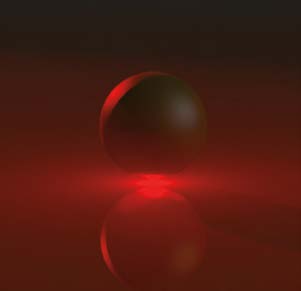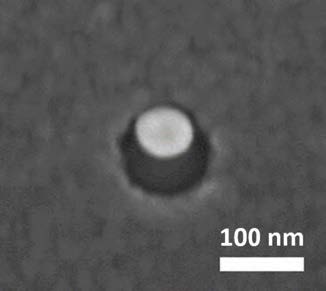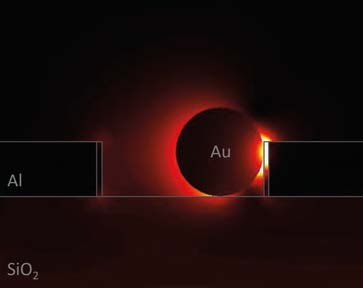The advent of plasmonics has enabled the focusing of visible light down to few-nanometer spot sizes, more than an order of magnitude below the diff raction limit. This extreme focusing enables the optical probing of volumes as small as a thousandth of an att oliter (10-24 m3), enabling biochemical sensors that operate at the few-molecule level even in high-concentration solutions. To enable practical plasmonic sensors, such nanoscale sensing structures should be chemically and structurally stable, as well as easily optically accessible. A recent study by the NanoPhotonics and Near-field Optics Group demonstrates a low-cost, stable nanoscale sensing pixel design that could enable ultrasensitive plasmonic sensor arrays.




The field of plasmonics has advanced tremendously over the past decade. Surface plasmons are optical modes that occur at the surface of conducting structures. The collective motion of free charges near metal surfaces allows metallic particles to act as resonant nanoscale optical antennas. These nanoantennas can generate unprecedented light concentration thanks to two separate contributions. First, optical excitation of a metallic nanostructure can resonantly drive charge motion, producing large charge oscillations and large optical fields at the particle surface. This eff ect alone can enhance the local light intensity by over two orders of magnitude. Second, the shape of the nanoparticle can aff ect the optical field enhancement, in the same way a lightning rod can concentrate electric field lines near the tip. Combined, these eff ects can efficiently concentrate light in fewnanometer spot sizes, which enables optical biochemical sensors with unprecedented sensitivity, down to the involve individual molecule level.
An example of a stable and easily prepared structure that combines these two eff ects is the “particle on a mirror” geometry. Figure 1 shows an artist’s rendering of a gold nanoparticle on an aluminum oxide coated gold mirror, illuminated with red light. Vertically oscillating charges on the 80 nm diameter gold particle are known to concentrate between the particle and its electric mirror image, producing what is known as a gap plasmon oscillation. In an earlier study, the concentrated optical field directly beneath the nanoparticle was shown to enhance metal photoluminescence by over five orders of magnitude. The strongly enhanced and focused optical field can also enhance other optical processes such as molecular fl uorescence and Raman scatt ering, enabling optical sensing in nanoscale volumes. One challenge with this particular geometry is the fact that the vertically polarized gap plasmon mode cannot be excited efficiently by normally incident light, limiting the practical utility of the structure. To overcome this challenge, graduate student ChatdanaiLumdee investigated a related nanostructure called the hole-in-one structure, consisting of a nanoaperture in a metallic film that is occupied by a single plasmon resonant nanoparticle.
The structures were fabricated at CREOL through nanosphere lithography using polystyrene nanospheres to produce 110 nm diameter apertures in an aluminum film on a glass substrate. Aft er deposition, the Al film developed a conformal few-nanometer thick native oxide on the top surface and on the sidewall of the apertures. Gold nanoparticles with a 60 nm diameter were deposited from colloidal solution, resulting in the capture of a single gold nanoparticle by some of the apertures. The generated structures were imaged using scanning electron microscopy (SEM) with the assistance of Kirk Scammon at the Materials Characterization Facility, revealing that the gold nanoparticles att ached to the oxide coated sidewall (Figure 2). This geometry corresponds to the desired ‘nanoparticle on a mirror’ geometry, where in this case the inner wall of the aperture acts as a curved mirror and the native oxide acts as a chemically and structurally stable spacer layer that ensures a reliable resonance wavelength. Numerical simulations of the generated structures predict large field enhancement and strong field confinement (Figure 3). Experimental proof for the existence of gap-plasmons in these structures was obtained by comparing the measured and simulated transmission spectra of a single aperture (Figure 4). The numerical and experimental results show clear evidence of plasmon enhanced optical transmission at a wavelength of ~650 nm, indicative of the presence of the predicted gap plasmons. Arrays of such hole-in-one structures could act as immersible sensing pixels for plasmon enhanced high-sensitivity molecular detection. Lumdee et al., APL Photonics 1, 031301 (2016)
The Nanophotonics and Near-field Optics group current research includes near-field optical interactions, plasmon optical devices, and nanoscale energy transfer processes.
Author
